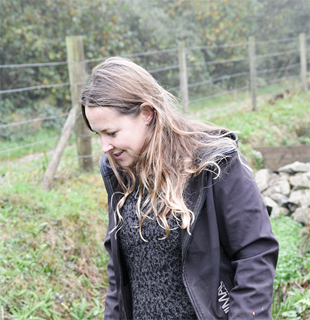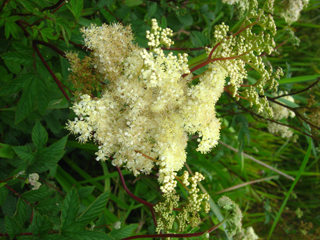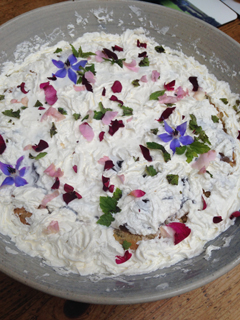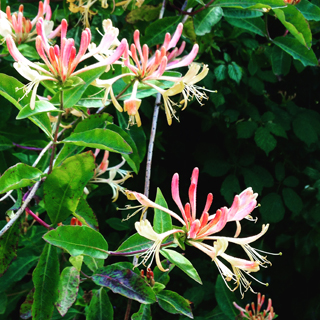 So where do I start? Shall I take people on a trip along hedgerows? Should I do coast to coast – North to South? Just the basics on what you can eat seasonally? Well, I think I’ll start at the beginning.
So where do I start? Shall I take people on a trip along hedgerows? Should I do coast to coast – North to South? Just the basics on what you can eat seasonally? Well, I think I’ll start at the beginning.
I’ve been gathering wild food since the age of about 13 or 14. My family and I moved from Singapore to England when I was 11, but after the school term had started, so once again I had to make a whole load of new friends. This was not a new thing – I’d moved from London to Singapore when I was 7 and had got quite used to making friends and moving.
So where am I going with this? Well, the precise moment when I got into foraging was when I went to my cousins’ school fete in St Hilary and bought a book called ‘Wild Food’ by Roger Phillips.  I also bought the game ‘hungry hippos’ but luckily that didn’t take me on a life journey, or else I would be writing about something very different! My first experience was taking my newly purchased book, my imitation Swiss army knife and my peanut butter and jam sandwiches down to the beach, by myself, and identifying plants such as sea rocket (Cakile maritima) and whittling a fork and a spoon from driftwood.
I also bought the game ‘hungry hippos’ but luckily that didn’t take me on a life journey, or else I would be writing about something very different! My first experience was taking my newly purchased book, my imitation Swiss army knife and my peanut butter and jam sandwiches down to the beach, by myself, and identifying plants such as sea rocket (Cakile maritima) and whittling a fork and a spoon from driftwood.
 This was my first experience by myself… and I loved it. I wasn’t exactly ‘green’ to the whole idea – my Dad would tell me about how my Great Grandmother would ask Dad, his brothers and cousins to forage for her, for things like marsh samphire (‘sampeth’) and sorrel (‘soursobs’). I have a vivid memory of walking the coast path from Lelant to St Ives and picking bracken fiddleheads, taking them home, cooking and eating them. They were pretty amazing, tasting like mushrooms and opening up the world of foraging just a little bit more. Another memorable experience was picking elderflowers with my Dad and making elderflower cordial. I remember the 24 hour wait of letting the ingredients steep, seemed like the longest amount of time I had ever known… but the taste was so worth it!
This was my first experience by myself… and I loved it. I wasn’t exactly ‘green’ to the whole idea – my Dad would tell me about how my Great Grandmother would ask Dad, his brothers and cousins to forage for her, for things like marsh samphire (‘sampeth’) and sorrel (‘soursobs’). I have a vivid memory of walking the coast path from Lelant to St Ives and picking bracken fiddleheads, taking them home, cooking and eating them. They were pretty amazing, tasting like mushrooms and opening up the world of foraging just a little bit more. Another memorable experience was picking elderflowers with my Dad and making elderflower cordial. I remember the 24 hour wait of letting the ingredients steep, seemed like the longest amount of time I had ever known… but the taste was so worth it!
So who am I? Well, I’m a garden designer, I’m an expert forager, I’m an artist and I have been working at the Eden Project for 18 years. I’ve been a guide, I’ve set up the medicinal plant database for the paramedics to use, I’ve worked as the landscape architect’s assistant, florist, I’ve done show gardens at many different horticultural shows… basically my passion lies deeply in plants with a use. Whether they are native, invasive, tropical, Mediterranean… I love them. Perhaps I’m a plant geek, and proud of it. I’m also a new Mum. My little girl is 9 1/2 months old and I can’t wait for her to try her first blackberry or say her first plant name!
 That brings us up to date. Are any of you well-seasoned foragers? Any beginners out there? Do you know nothing about the subject but want to get yourself and perhaps your family involved? Well, let me help!
That brings us up to date. Are any of you well-seasoned foragers? Any beginners out there? Do you know nothing about the subject but want to get yourself and perhaps your family involved? Well, let me help!
The way I see foraging is that it’s for everyone. If you’re a beginner, just take one step at a time. Get to know a few easily recognisable plants first and get to know the best ways of using and eating them. If you’re already an expert, perhaps I can tempt you with new recipes or new ideas. I love the way foraging can get you to explore new places, see familiar areas even more intimately and the flavours – wow, some of the flavours are so unique, delicious, versatile… if there’s one thing I hope you get from this, it’s tasting new flavours. Month by month, new flavours awaken as plants reach their peak. At a very basic level, spring is ideal for new shoots and new leaves, summer is good for edible flowers and fruits ripening, autumn for fruits and nuts and winter is good for roots as they are at their sweetest. Shellfish and certain seaweeds tend to be good to harvest in the winter too.
 August is around the corner so what is in store for us?
August is around the corner so what is in store for us?
Keep an eye out for a good variety of late summer mushrooms such as field mushrooms, chanterelles and ceps. Mushrooms are pretty specific as to when they emerge and especially where they grow. Wild strawberries start ripening from June but carry on through the next months, so get ready to pick and make jams with them. Honeysuckle has a good few months of flowering – what I like to do is make honeysuckle cordial with them which I then use for vinaigrettes, drinks, jelly and many other desserts. If you enjoy walks along hedgerows, then this is the perfect time for meadowsweet. If you haven’t used it before, the leaves can be used for an aspirin substitute and the flowers can be used to stew with fruits to reduce the amount of sugar you use. Certain fish are good to catch too, for example grey mullet, herring and sardines.
So my first recipe to share with you is hedgerow trifle. This uses honeysuckle jelly and rose petal and lemon balm sponge… I hope you enjoy it!
 Hedgerow trifle with honeysuckle jelly and rose petal & lemon balm sponge (v)
Hedgerow trifle with honeysuckle jelly and rose petal & lemon balm sponge (v)
- 2-3 cups honeysuckle flowers
- caster sugar
- orange zest and juice
- water
- 2 sachets vege-gel (vegetarian gelatine)
- 1 cup mashed wild strawberries (optional)
- 110g caster sugar
- 110g butter
- 2 eggs
- 110g self-raising flour
- 1 tsp baking powder
- 1 cup lemon balm leaves, shredded
- 1 cup scented rose petals, shredded
- rose water OR orange flower water
- whipped cream
- edible leaves and flowers to decorate
Honeysuckle jelly – put the honeysuckle flowers in a measuring jug with the lemon zest/juice OR orange zest/juice and add boiling water to make it up to about 800ml. When it has cooled enough to sample, add sugar to taste. Leave to infuse until it has cooled. Once completely cool, pour it through a sieve into a saucepan and add the sachets of vege-gel. Bring to the boil, take off the heat, add in the mashed strawberries if using and pour into a heat-proof mould. Pop it in the fridge to set.
The sponge – Preheat the oven to 180 degrees (fan assisted). Cream the butter and sugar together until pale. Add the eggs, beating them in to combine, add the shredded lemon balm and rose petals then sieve in the baking powder and the SR flour, folding until combined. Pour into a greased tin and bake for about 15 mins. Leave to cool completely.
Combine everything – Pick a deep dish and put the sponge in the base. Drizzle a little rose water or orange flower water onto the sponge and spoon the jelly to form the next layer. Finish it with whipped cream and decorate with edible flowers and leaves.
For recipes, information on foraging, to purchase the foraging books or tea towels, and other details check out www.nevermindtheburdocks.co.uk
Facebook: Never mind the burdocks – Twitter: Nmtheburdocks

